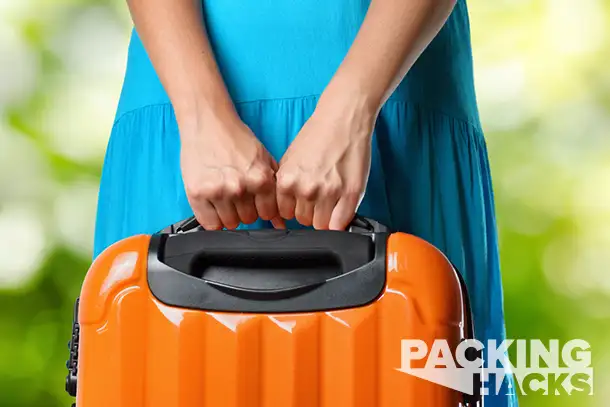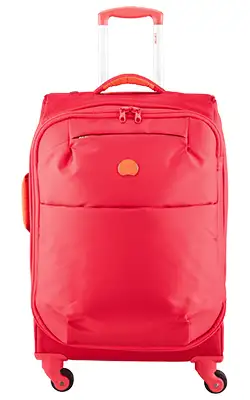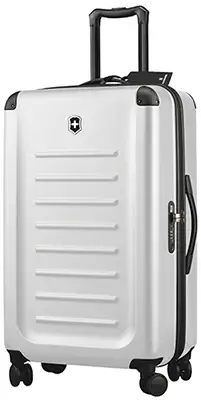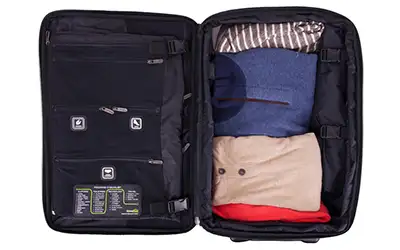
Packing Hacks is a 31-part series devoted to helping you become an expert packer! Each installment offers advice on how to get organized, pack smarter, save on bag fees, and eliminate packing stress. New to Packing Hacks? Start at the beginning.
Yesterday, we introduced you to our Packing Hacks series. Today, we’re going back to the basics with our inaugural post on selecting a new suitcase.
You’ll learn:
√ What to consider in a new suitcase
√ How to compare baggage features
√ How to arrive at the best-for-you decision about your next piece of luggage
There are so many suitcase options out there, many with bells and whistles and add-ons galore. It can get pretty overwhelming. So how do you know what to look for when shopping for a new carry-on or checked bag? We’re here to help.
Size and Weight
First, narrow down your luggage search by focusing on size and weight. We all know that the airlines have a lot to say about this. If your bag is heavy to begin with, chances are much higher that it will rack up overweight-bag fees once it’s packed. Likewise for size: If your new carry-on pushes the limits of the airline’s size restrictions and overhead-bin space, you’re going to have to deal with the consequences (read: fees). What you want in a suitcase is best summed up by the Goldilocks principle: a bag that is not too big, not too small, but just right (for you).
The guidelines, of course, vary from airline to airline, but a good rule of thumb is to look for checked baggage that is less than 62 linear inches and carry-on baggage that is less than 45 linear inches (linear inches = upright height + depth + width).
 In addition to airline requirements, think about your own requirements: your lifestyle, health, and particular needs. Do you have a bad back? You’ll want to look for an ultra-lightweight suitcase, such as Delsey’s For Once Lite carry-on or its U-Lite checked bag. Do you love to bring home souvenirs from your travels? Try an expandable suitcase, such as L.L.Bean’s expandable carry-on.
In addition to airline requirements, think about your own requirements: your lifestyle, health, and particular needs. Do you have a bad back? You’ll want to look for an ultra-lightweight suitcase, such as Delsey’s For Once Lite carry-on or its U-Lite checked bag. Do you love to bring home souvenirs from your travels? Try an expandable suitcase, such as L.L.Bean’s expandable carry-on.
Wheels
After considering size and weight, think about mobility. This may seem simple—you can go with two wheels, or you can go with four—but there are a few things to factor in before making a choice.
Two Wheels: Two-wheeled or inline-wheeled luggage has been on the market longer than four-wheeled models, so there are more bags from which to choose. The wheels, which roll forward and backward, are recessed into the case; this saves a bit of space and also protects the wheels from damage. The design of two-wheelers generally means they are easier to maneuver on uneven surfaces. The main drawback to this style of bag is that you must drag it behind you. This pulling motion can cause strain to wrists and shoulders. Anyone prone to pain in these areas should go with a four-wheeled spinner instead.
Four Wheels: Four-wheeled bags, or spinners, use wheels that rotate 360 degrees, which means you can turn the bag in any direction. This provides improved mobility and gives you options: You can roll the bag next to you, push it, or pull it. But those protruding wheels take up space in the overhead bin and are more likely to snap off or suffer damage; it’s wise to check the warranty before purchasing this type of bag. In addition, if you’re considering a carry-on, make sure the dimensions listed are wheel-inclusive. Airlines will include the wheels when they measure your carry-on, so you should too.
Try taking a field trip to a department or luggage store to test out the different types of wheels on the market. Even within these two categories, there is a lot of variation. Some spinners roll like a dream while others feel difficult to control; the same can be said for two-wheeled bags.
Color
Spare yourself the inconvenience of The Black-Bag Clone: When black bag after black bag is careening by, a colorful suitcase will be noticeable, cheerful, and bright—and, most important, easy to identify. You’ll thank me later, when you breeze through baggage claim without grabbing the wrong suitcase or missing yours on the first go-round of the conveyer belt. One fewer hassle can make a big difference in your mood at the beginning or end of a trip—plus you’ll save precious time.
If you opt for classic black—which generally shows the least amount of wear and tear—tie some colored ribbon or a scarf to the handle or strap on a bright luggage belt, like one of these Luggage Huggers from TravelSmith.
Construction
Think of your suitcase as your forever friend. You want this relationship to last a lifetime, right? So, on your quest for new luggage, be discerning about materials and construction. After all, if you choose wisely, your bag will be your constant rolling companion for many years to come.
 Hard-Sided: It seems like hard-sided suitcases are being upgraded and improved upon almost daily. Companies are now using ultra-lightweight materials, such as polycarbonate and special plastics, to make bags that are featherweight but also extremely durable and strong. These protective shells ensure that your belongings stay safe from airline damage. But they also mean that your bag is stiff and might not be able to squeeze into that last bit of space in the overhead bin—and when packing, you might not be able to cram in that one last outfit.
Hard-Sided: It seems like hard-sided suitcases are being upgraded and improved upon almost daily. Companies are now using ultra-lightweight materials, such as polycarbonate and special plastics, to make bags that are featherweight but also extremely durable and strong. These protective shells ensure that your belongings stay safe from airline damage. But they also mean that your bag is stiff and might not be able to squeeze into that last bit of space in the overhead bin—and when packing, you might not be able to cram in that one last outfit.
Soft-Sided: If you want flexibility, soft-sided luggage is the way to go. These bags are lightweight—generally lighter than hard-sided bags—which makes them easier to sling into overhead bins and the like. Be discriminating about fabrics, though. Look for a bag made from ballistic nylon (or another durable nylon), which provides the best protection against wear and tear. And make sure the fabric is waterproof and stain-proof.
Additional Features
Your suitcase should reflect you—your style, your frequency of use, your particular needs and requirements. So what type of traveler are you? An adventurer? A frequent flyer? Think about where and how you travel and what you tend to pack when considering these extras.
Handles: Look for a sturdy handle that feels comfortable and is ergonomically designed. A handle system that is built into the inside of the bag is best, because the handle is protected from damage. Test out the handle: Extend it to its full length, make sure it locks (and stays locked), and take the bag for a spin. If the suitcase is jabbing you in the backs of the legs, that means the handle isn’t long enough for your height.
Zippers: The bigger the zipper, the longer it will last and the better it will stand up to the abuses of travel. Go for metal over plastic, and look for self-repairing zippers—so called because in the event of a snag in the zipper’s teeth, pulling the zipper back down and over the snag fixes the problem and reseals the teeth.
TSA-Approved Locks: If you want extra security, choose a bag that includes a TSA-approved lock. Briggs & Riley’s Torq checked bag is one example of a high-quality suitcase that features a built-in TSA-approved combination lock.
Pockets:  When it comes to pockets, soft-sided bags generally win. (The construction of hard-sided suitcases doesn’t allow for many extra pockets and outer compartments.) If you love organization—a place for everything and everything in its place—there are lots of bags on the market for you. One great example is GeniusPack’s innovative carry-on, which features everything from a hidden laundry-chute bag to a pop-out pocket for your umbrella.
When it comes to pockets, soft-sided bags generally win. (The construction of hard-sided suitcases doesn’t allow for many extra pockets and outer compartments.) If you love organization—a place for everything and everything in its place—there are lots of bags on the market for you. One great example is GeniusPack’s innovative carry-on, which features everything from a hidden laundry-chute bag to a pop-out pocket for your umbrella.
Warranty and Cost
Thoroughly read the warranty policy before purchasing a bag. Ideally, you want to buy from a company that provides lifetime warranties on its luggage. Companies with some of the most comprehensive warranties out there include Victorinox, Briggs & Riley, and Travelpro.
One last thought: You get what you pay for. I recommend investing a little more in order to get the most out of your suitcase. The cost of replacing a cheap bag every year or so will add up eventually, so spend a little more upfront to get a suitcase that that will be with you for the long haul.
Up next: Day 3: Proven Hacks for Lighter, Tighter, Better Packing.
We hand-pick everything we recommend and select items through testing and reviews. Some products are sent to us free of charge with no incentive to offer a favorable review. We offer our unbiased opinions and do not accept compensation to review products. All items are in stock and prices are accurate at the time of publication. If you buy something through our links, we may earn a commission.
Related
Top Fares From
Today's Top Travel Deals
Brought to you by ShermansTravel
Porto to Lisbon: 7-Nt, Small-Group Portugal...
Indus Travels
 vacation
$1899+
vacation
$1899+
Luxe, 12-Night Spain, France, Monaco &...
Regent Seven Seas Cruises
 cruise
$12599+
cruise
$12599+
Ohio: Daily Car Rentals from Cincinnati
85OFF.com
 Car Rental
$19+
Car Rental
$19+



